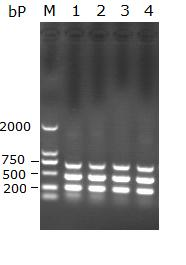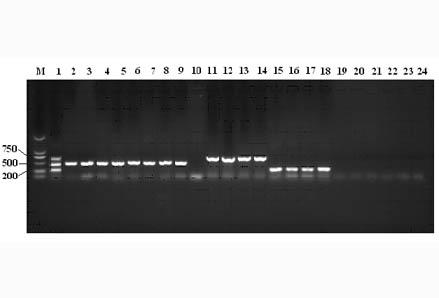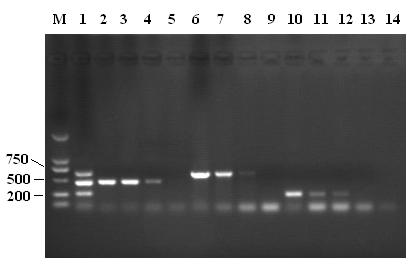Multi-PCR detection kit and detection method for duck-origin common bacteria
A technology for detection kits and detection methods, applied in biochemical equipment and methods, measurement/inspection of microorganisms, resistance to vector-borne diseases, etc., can solve problems such as batch detection, cumbersome fabrication, long detection time, etc., and achieve shortening The effect of detection time, specificity, simple operation and great economic benefits
- Summary
- Abstract
- Description
- Claims
- Application Information
AI Technical Summary
Problems solved by technology
Method used
Image
Examples
Embodiment 1
[0033] 1. Establishment of a multiplex PCR detection kit for common bacteria from ducks
[0034] Prepare the duck plague bacteria multiplex PCR detection kit according to the following composition:
[0035] Contains 10× reaction buffer, DNA polymerase, dNTP (2.5mM each), 50% Glycerol, and 3 pairs of primers whose sequences are:
[0036] RA DnaB P1: AAACTCAGGCAAAGGTGGCAC (SEQ ID NO. 1)
[0037] RA DnaB P2: TGTATGGTAGTTTTGATGCTTTCAA (SEQ ID NO. 2)
[0038] E. coli phoA P1: CGATTCTGGAAATGGCAAAAG (SEQ ID NO. 3)
[0039] E. coli phoA P2: CGTGATCAGCGGTGACTATGAC (SEQ ID NO. 4)
[0040] Salm invA P1: AACCAGCAAAGGCGAGCAG (SEQ ID NO. 5)
[0041] Salm invA P2: CAATACGATGCTGTTATCGTCCAG (SEQ ID NO. 6)
[0042] Establishment of Multiplex PCR Reaction System and Reaction Conditions
[0043] The present invention optimizes conditions such as the proportioning concentration of each primer, the concentration of glycerol, and the amount of Taq DNA polymerase, and the finally determined react...
Embodiment 2
[0054] Embodiment 2: Multiplex PCR method is to the detection of Riemerella anatipestifer, escherichia coli and Salmonella wild strain in the laboratory (can finish within 3 hours)
[0055] 130 strains of Riemerella anatipestifer, 68 strains of Escherichia coli and 28 wild strains of Salmonella preserved in the laboratory were detected by using the established multiplex PCR method.
[0056] (1) Preparation of bacterial DNA template
[0057] Single colonies of Riemerella anatipestifer, Escherichia coli and Salmonella on TSA / LB were inoculated into TSB or LB liquid medium respectively, and shaken at 37 °C. Then transfer again at 1:100, shake the bacteria until OD600=0.6-0.8, take 0.5mL bacterial solution into 1.5ml Eppondorf tubes, boil at 100°C for 5 minutes, cool at room temperature, and set aside at -20°C. The mixture of three known bacteria, Riemerella anatipestifer, Escherichia coli and Salmonella, was boiled as a positive control; in addition, deionized water was used ins...
Embodiment 3
[0070] Embodiment 3: multiplex PCR is to the detection of clinical sample (can finish within 5 hours)
[0071] Six samples were obtained from brain and liver tissues from ducks infected with Riemerella anatipestifer, E. coli or Salmonella in the laboratory. The liver and brain tissues of 18 dead ducks were collected from the diseased duck farm and suspected to be infected by bacteria (9 ducks in total).
[0072] (1) Preparation of DNA template
[0073] A small amount of liver and brain tissues of dead ducks were taken aseptically, and genomic DNA was extracted with QiAamp? DNA mini kit as a template. Standby at -20°C. The mixture of three known bacteria, Riemerella anatipestifer, Escherichia coli and Salmonella, was boiled as a positive control; in addition, deionized water was used instead of DNA template as a negative control.
[0074] (2) Prepare a multiplex PCR detection reaction system according to the following composition:
[0075] Reaction Component
Volu...
PUM
 Login to View More
Login to View More Abstract
Description
Claims
Application Information
 Login to View More
Login to View More - R&D
- Intellectual Property
- Life Sciences
- Materials
- Tech Scout
- Unparalleled Data Quality
- Higher Quality Content
- 60% Fewer Hallucinations
Browse by: Latest US Patents, China's latest patents, Technical Efficacy Thesaurus, Application Domain, Technology Topic, Popular Technical Reports.
© 2025 PatSnap. All rights reserved.Legal|Privacy policy|Modern Slavery Act Transparency Statement|Sitemap|About US| Contact US: help@patsnap.com



